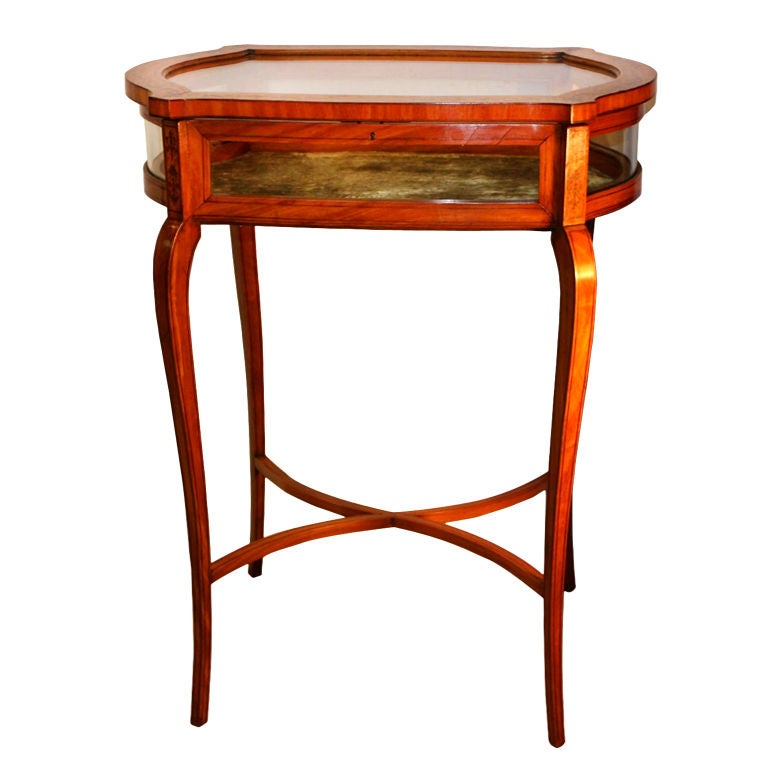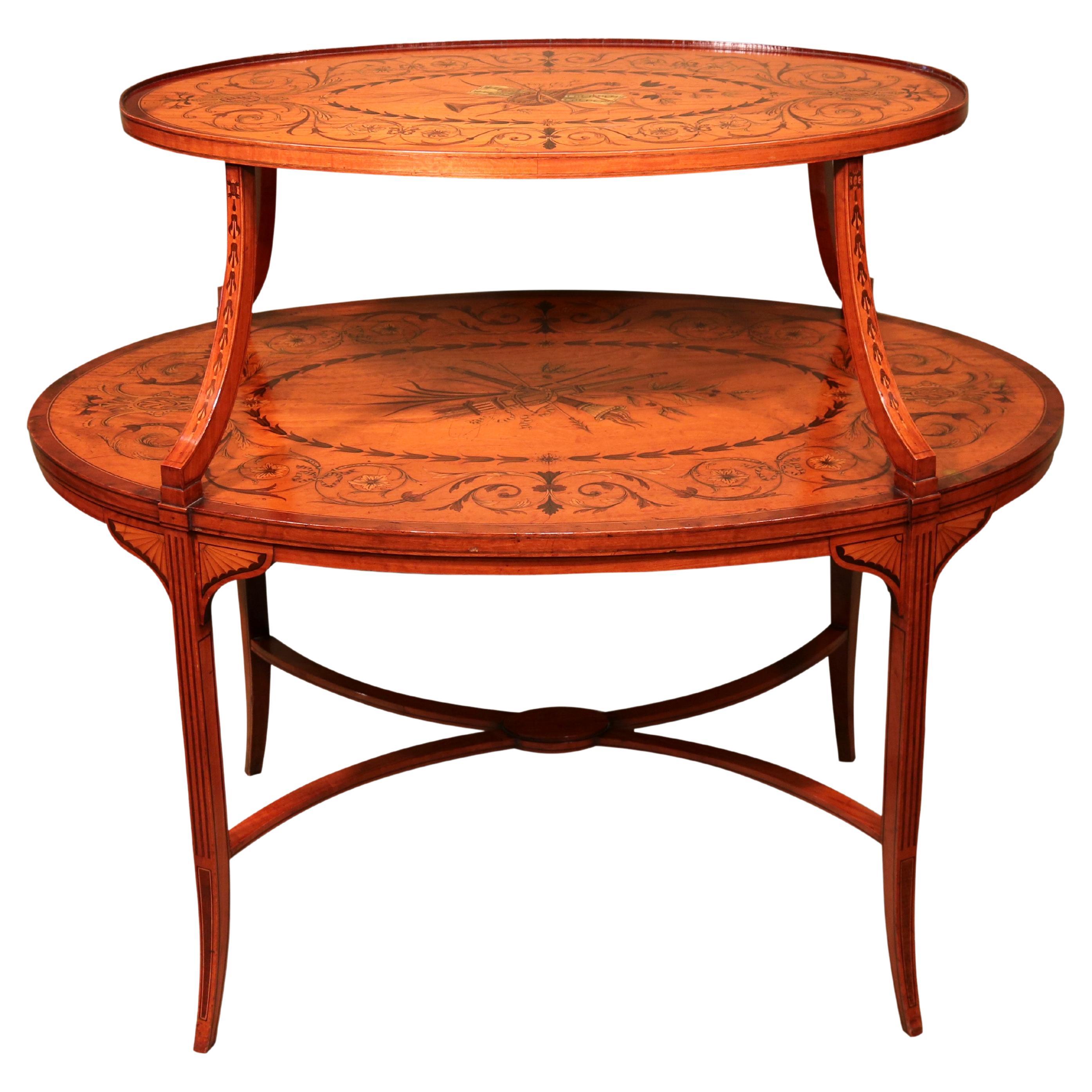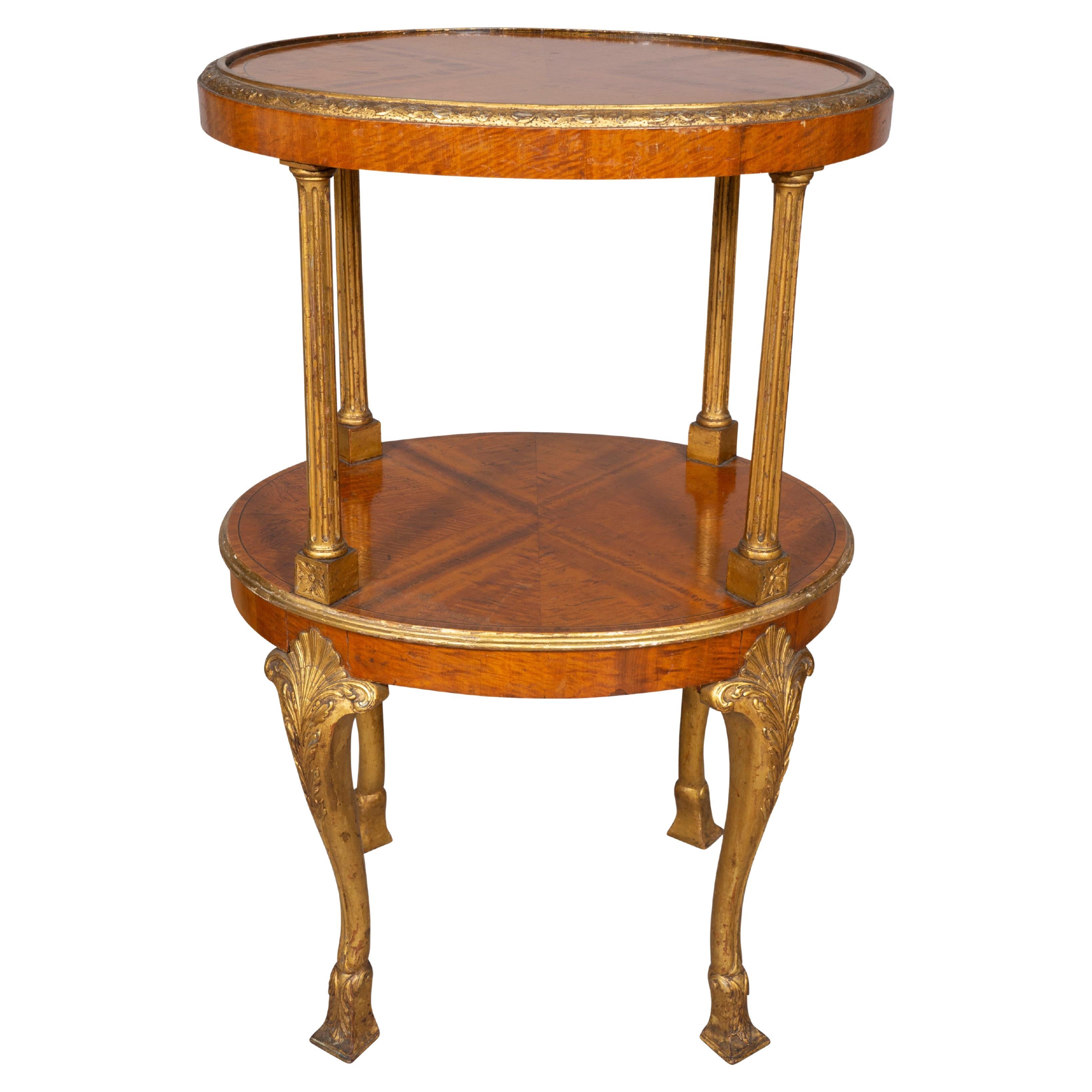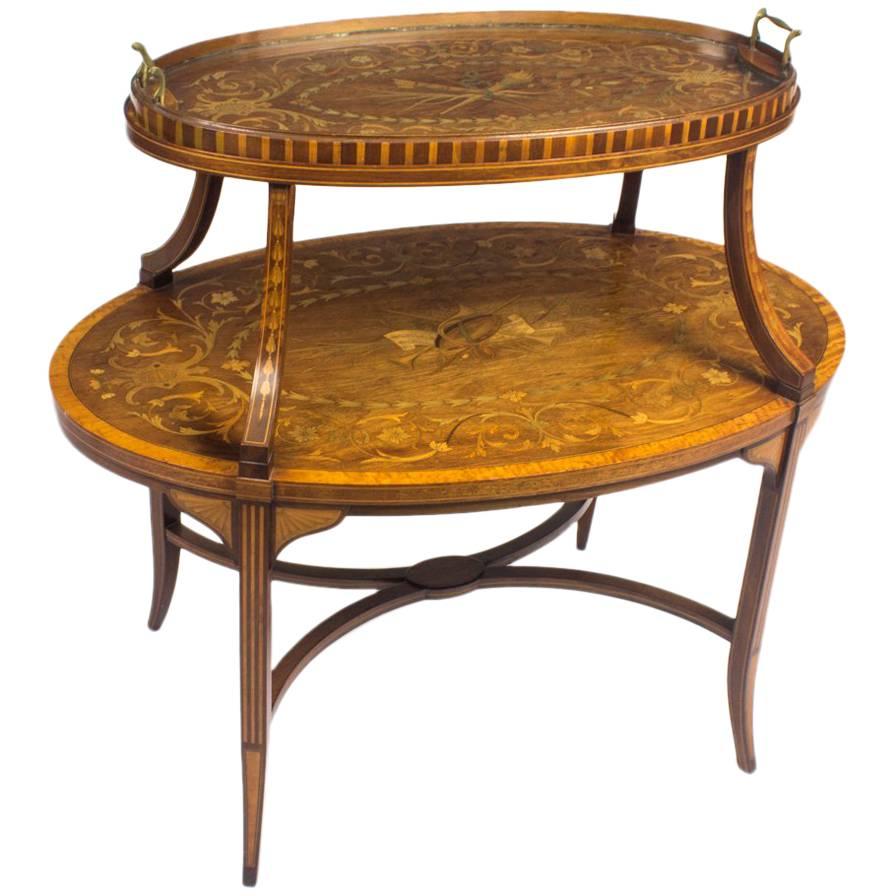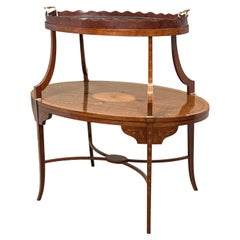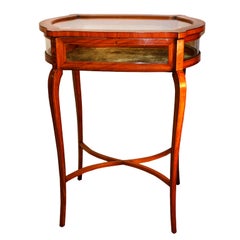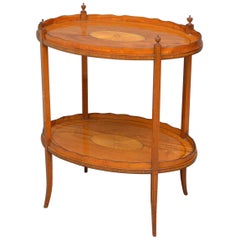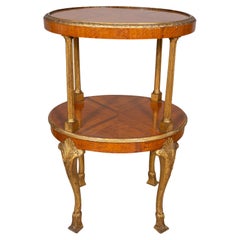Video Loading
Want more images or videos?
Request additional images or videos from the seller
1 of 14
19th Century Satinwood Oval Étagère
$3,028.95
$3,786.1920% Off
£2,200
£2,75020% Off
€2,591.27
€3,239.0920% Off
CA$4,149.51
CA$5,186.8920% Off
A$4,604.24
A$5,755.3020% Off
CHF 2,411.80
CHF 3,014.7520% Off
MX$56,460.29
MX$70,575.3720% Off
NOK 30,677.24
NOK 38,346.5520% Off
SEK 28,958
SEK 36,197.5120% Off
DKK 19,324.72
DKK 24,155.9020% Off
Shipping
Retrieving quote...The 1stDibs Promise:
Authenticity Guarantee,
Money-Back Guarantee,
24-Hour Cancellation
About the Item
A fine quality late 19th century satinwood oval two tier etagere, or dumbwaiter, having removable lift off glass tray top and superbly figured veneers with crossbanded and inlaid decoration raised on four elegant splayed legs united by central shaped cross stretcher.
This little table is both elegant and useful, combining the two beautifully it must be said. The design is fairly typical of the production output of the workshops of the top London cabinet makers in the late 19th and early 20th centuries and it is constructed from the finest available satinwood of the time with excellent additional banded and inlaid decoration.
It exudes elegance and sophistication throughout and would make a perfect occasional table to use for entertaining with drinks due to the lift off glass top. Overall the condition is good and it has very clearly been well loved and cherished as well used throughout the many years of its life.
Circa 1890.
Height 32in.
Width 35in.
Depth 22.5in.
- Dimensions:Height: 32 in (81.28 cm)Width: 35 in (88.9 cm)Depth: 22.5 in (57.15 cm)
- Style:Edwardian (Of the Period)
- Materials and Techniques:
- Place of Origin:
- Period:
- Date of Manufacture:circa 1890
- Condition:Wear consistent with age and use.
- Seller Location:Bedfordshire, GB
- Reference Number:Seller: 26571stDibs: LU955826807942
About the Seller
5.0
Gold Seller
Premium sellers maintaining a 4.3+ rating and 24-hour response times
Established in 1975
1stDibs seller since 2012
161 sales on 1stDibs
Typical response time: <1 hour
Associations
LAPADA - The Association of Arts & Antiques DealersInternational Confederation of Art and Antique Dealers' AssociationsThe British Antique Dealers' Association
- ShippingRetrieving quote...Shipping from: Bedfordshire, United Kingdom
- Return Policy
Authenticity Guarantee
In the unlikely event there’s an issue with an item’s authenticity, contact us within 1 year for a full refund. DetailsMoney-Back Guarantee
If your item is not as described, is damaged in transit, or does not arrive, contact us within 7 days for a full refund. Details24-Hour Cancellation
You have a 24-hour grace period in which to reconsider your purchase, with no questions asked.Vetted Professional Sellers
Our world-class sellers must adhere to strict standards for service and quality, maintaining the integrity of our listings.Price-Match Guarantee
If you find that a seller listed the same item for a lower price elsewhere, we’ll match it.Trusted Global Delivery
Our best-in-class carrier network provides specialized shipping options worldwide, including custom delivery.More From This Seller
View AllFine 19th Century Mahogany & Satinwood Two Tier Table
Located in Bedfordshire, GB
A Very Fine Quality Late 19th Century Mahogany And Satinwood Oval Two Tier Etagere, Dumb Waiter, Or Occasional Table, Having Removable Glass Tray With Wavy Galleried Edge To Top, Rai...
Category
Antique Late 19th Century English Edwardian End Tables
Materials
Mahogany, Satinwood
$5,066 Sale Price
20% Off
19th Century Laburnum Wood Occasional Table
Located in Bedfordshire, GB
An Extremely Unusual Mid 19th Century, William IV Period, Laburnum Wood Occasional Lamp Table, Having Superbly Figured Circular Drum Type Top, Over Three Concealed Drawers To Frieze,...
Category
Antique Mid-19th Century English William IV Tables
Materials
Other
$4,846 Sale Price
20% Off
Georgian Satinwood Demi Lune Tea Table
Located in Bedfordshire, GB
A Very Good Quality George III, Sheraton Period, Satinwood Demi Lune Shaped Tea Table Having Exceptionally Well Figured Folding Top, With Wide Crossbanded Decoration, Over Inlaid F...
Category
Antique Late 18th Century English Sheraton Card Tables and Tea Tables
Materials
Satinwood
$5,121 Sale Price
20% Off
Early 19th Century Mahogany Tricoteuse Occasional Table
Located in Bedfordshire, GB
An Extremely Elegant Early 19th Century, French Empire Period, Mahogany Tricoteuse Type Occasional Table, Having Extremely Well Figured Rectangular Galleried Top, Over One Drawer To ...
Category
Antique Early 19th Century French Empire Tray Tables
Materials
Mahogany
$4,020 Sale Price
20% Off
19th Century Amboyna Occasional Table
Located in Bedfordshire, GB
A delightful 19th century occasional lamp, or wine table, with well figured amboyna circular top and ormolu moulding raised on three elegant ebonized and inlaid turned supports, terminating with triform plateau and elegant sabre feet.
Although victorian in date this table draws on a variety of different stylistic features, from a range of different periods. The use of beautiful amboyna veneers, set against ebonised mouldings is very much a 19th century feature however, the contrast created providing both a boldness and elegance all in one.
This little occasional table is constructed from excellent timbers and when taking into account the overall quality of construction as well it is clear that it was produced in one of the top cabinet makers workshops of the time.
Surprisingly sturdy for such a small article, which is due to the intelligent triple support design, this is a most practical table indeed, perfect for a wide variety of spots around the home, where one can use it to house a lamp, some photo frames or even a nice glass of wine.
It is a great size and should fit elegantly into just about spot desired. Overall the condition is good and as with all items which we offer for sale it has received a natural wax polish by our highly skilled, traditional antique furniture...
Category
Antique Late 19th Century English Victorian Tables
Materials
Amboyna
$4,791 Sale Price
20% Off
18th Century Mahogany Oval Pembroke Table
Located in Bedfordshire, GB
A very good quality Georgian, 18th century, mahogany oval Pembroke table, having well figured top with two drop flaps and crossbanded decoration, over one frieze drawer opposed by on...
Category
Antique Late 18th Century English Georgian Drop-leaf and Pembroke Tables
Materials
Mahogany
$5,727 Sale Price
20% Off
You May Also Like
Edwardian Satinwood Bijouterie Table
Located in Montreal, QC
Edwardian satinwood display or bijouterie table with marquetry and stringing, the locking lift top fitted with curved front and back panes, the sides ...
Category
Early 20th Century English Edwardian Gueridon
Materials
Glass, Satinwood
Edwardian Satinwood Two Tier Etargere
Located in London, GB
A two tier Edwardian period satinwood oval etagere, beautifully inlaid with a variety of exotic woods. The top tier has a removable two-handled tray.
Category
Early 20th Century English Edwardian Side Tables
Materials
Satinwood
Late Victorian Satinwood Tray Table
Located in Whaley Bridge, GB
Sn4484, late Victorian satinwood tray table of oval form with two-tier decorated with sunburst inlays and solid shaped gallery with turned finials, standing on slender, string inlaid...
Category
Antique 1890s English Late Victorian Tray Tables
Materials
Satinwood
$2,037 Sale Price
20% Off
Edwardian Satinwood and Gilded Table
Located in Essex, MA
The finest quality. Oval top with quarter veneers and with crossbanded detailed carved edge over a conforming shelf divided by columns and raised on well carved cabriole legs joining...
Category
Antique 1710s English George I Side Tables
Materials
Satinwood, Giltwood
19th Century Satinwood Centre Table
Located in Martlesham, GB
19th century inlaid satinwood centre / occasional table, with an oval shaped top, the apron below profusely inlaid all over, standing on tapering legs with spade feet and brass casto...
Category
Antique 1890s English Victorian Center Tables
Materials
Satinwood
$1,817 Sale Price
20% Off
19th Century English Mahogany & Satinwood Etagere Tray Table
Located in London, GB
This is a truly exceptional antique English Edwardian mahogany and satinwood marquetry oval two tier 'etagere', in the manner of Edwards & Roberts, circa 1890 in date.
Crafted from the best flame mahogany, note the wonderful grain to the wood and the beautifully inlaid decoration with musical trophies within scrolling foliage and kingwood crossbanding.
Masterfully inlaid with Sheraton influences, this etagere has an elegant refined look.
The removable glass bottomed tray can be used to serve drinks, etc.
It is raised on elegant square section tapering outswept legs with a shaped cross stretcher.
The craftsmanship and finish are second to none.
THE BOTANICAL NAME FOR THE MAHOGANY THAT THIS ITEM IS MADE OF IS SWIETENIA MACROPHYLLA AND THIS TYPE OF MAHOGANY IS NOT SUBJECT TO CITES REGULATION AND DOES NOT CONTAIN ANY RESTRICTED MATERIALS.
Condition:
In excellent condition having been beautifully cleaned and waxed in our workshops, please see photos for confirmation.
Dimensions in cm:
Height 84 x Width 89 x Depth 55
Dimensions in inches:
Height 33.1 x Width 35.0 x Depth 21.7
Edwards & Roberts
was founded in 1845, and had premises at 21 Wardour Street London. By the 1892 they occupied more than a dozen buildings in Wardour Street, where they continued to trade until the end of the century.
They became one of the leading London cabinet makers and retailers working in a variety of styles, both modern and revivalist. Their business also involved retailing, adapting and restoring the finest antique furniture and there are many examples of their earlier furniture with later embellishments bearing their stamp.
Edwards & Roberts specialised in marquetry, inlay and ormolu.
Marquetry is decorative artistry where pieces of material (such as wood, pewter, or brass silver) of different colours are inserted into surface wood veneer to form intricate patterns such as scrolls or flowers.
The technique of veneered marquetry had its inspiration in 16th century Florence. Marquetry elaborated upon Florentine techniques of inlaying solid marble slabs with designs formed of fitted marbles, jaspers and semi-precious stones. This work, called opere di commessi, has medieval parallels in Central Italian "Cosmati"-work of inlaid marble floors, altars and columns. The technique is known in English as pietra dura, for the "hardstones" used: onyx, jasper, cornelian, lapis lazuli and colored marbles. In Florence, the Chapel of the Medici at San Lorenzo is completely covered in a colored marble facing using this demanding jig-sawn technique.
Techniques of wood marquetry were developed in Antwerp and other Flemish centers of luxury cabinet-making during the early 16th century. The craft was imported full-blown to France after the mid-seventeenth century, to create furniture of unprecedented luxury being made at the royal manufactory of the Gobelins, charged with providing furnishings to decorate Versailles and the other royal residences of Louis XIV. Early masters of French marquetry were the Fleming Pierre Golle and his son-in-law, André-Charles Boulle, who founded a dynasty of royal and Parisian cabinet-makers (ébénistes) and gave his name to a technique of marquetry employing brass with pewter in arabesque or intricately foliate designs.
Etagère is a piece of light furniture which was extensively made in France during the latter part of the 18th century. It consists of a series of stages or shelves for the reception of ornaments or other small articles. Like the what-not it was very often cornerwise in shape, and the best Louis XVI examples in exotic woods are exceedingly graceful and elegant.
In modern usage, an étagère is often used to refer specifically to a long-legged shelf unit that fits over a bathroom toilet...
Category
Antique 1890s English Edwardian Tray Tables
Materials
Mahogany, Satinwood
More Ways To Browse
Table Top Etagere
Two Tier Etagere
Edwardian Drinking Glasses
Oval Edwardian Cabinet
Edwardian Two Tier Table
Dumbwaiter Cabinet
Edwardian Drinks Table
Edwardian Drinks Cabinet
Edwardian Etagere
Antique Butler Stand
Chinese Brass Tray
Large Brass Round Tray
Antique Tole Painted Trays
Bed Tray Table
Brass Islamic Table
George Iii Mahogany Tray
Painted Papier Mache Table
Middle Eastern Brass Table
